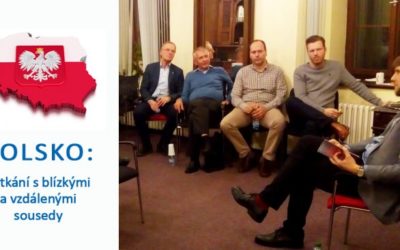Last week on Tuesday was the first and unfortunately for a long time the last “Meeting with neighbours”. The series of lectures on neighbouring countries was opened by Maciej Ruczaj, Director of the Polish Institute in Prague. He told us about his native Poland and helped us to establish this format, for which he deserves a big thank you. We learned a lot of interesting information about the economy, history, architecture and culture of the country. The article brings you the most interesting.
A neighbour near and far
Did you know that Poland is the only European country that has ceased to exist completely several times in its history? Unlike France or Germany, its existence is not at all self-evident. Another interesting fact is that, although we have been neighbours for more than 500 years, our histories did not intertwine for the first time until 1945. Poland is therefore in essence both a near and a distant neighbour. There is therefore no harm in taking more interest in it.
Modern architecture and speed of construction
1945 was also a defining year for Poland in a completely different way. The end of the war left havoc in its wake and 85% of pre-war Polish architecture and infrastructure succumbed to the fury of war. The whole of Poland is therefore dominated by modern architecture today.
However, the rapid construction of the post-war era has not been forgotten by the Poles in the present day. Compared to our few kilometres of motorway per year, the Polish side can build up to 200 kilometres per year. The Polish population is also subject to the same rapid change. Although some Poles have recently returned to the country, Poland has traditionally been seen as an emigrant country. In Britain, for example, almost one million settled after joining the EU. But Poland also has a positive attitude towards immigrants. In 2019 alone, Polish authorities granted about 500,000 residence permits.
Food cases
However, Poland is not only a dynamically developing country from which we could learn a lot, there are also numerous food scandals associated with it. You can probably all think of the sprinkling salt in sausages and baked goods from Poland, salmonella bacteria in minced pork, banned antibiotics and pharmaceuticals in chicken meat, or the excessive water content in butter. However, the whole situation is much more complicated. In Poland, the food industry is indeed highly developed and capable of meeting even the most stringent standards. After all, in 2018 alone, Poland exported EUR 29 billion worth of food to the EU, of which Germany received 23% and the Czech Republic 17.8%. Do you think the Germans complain more about Polish food? They don’t. This is mainly because multinational chains have mainly ordered the cheapest food for the Czech Republic without any guarantee of quality. We all remember the case of the double quality of foodstuffs. Nevertheless, it must be stated unequivocally that there are limits beyond which no supplier should go.
Poland is one step ahead of its neighbours
Just as Polish architecture is modern, Poles love everything new and modern. If you want to know what will be fashionable in Prague in 3 years, go to Poland. It’s no coincidence that the Poles have a huge shoe and clothing industry. Did you know that the brands Reversed, Cropp, CCC, Boti and Lasocki are Polish? Poland is also home to 50% of Ikea’s furniture and almost 60% of LG’s appliances.
Moreover, Poland has recently scored a global literary success. Polish writer Andrej Sapkowski, author of short stories and a novel about the Witcher, has gained worldwide fame. His books have been the basis for several globally successful computer games, Netflix has made a successful series based on them, and an animated series is also planned.
Want to fill in more interesting information about the economy, culture and history of our neighbours? Follow us on our Blog, Facebook or LinkedIn, just so you are guaranteed not to miss anything important.

